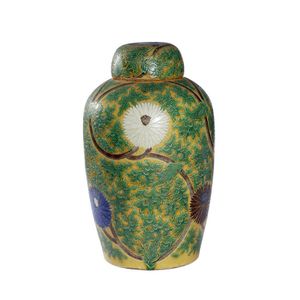Qing Dynasty Sancai Jar with Floral Motifs
A Chinese Sancai ovoid jar and cover, Qing Dynasty, incised and painted all over with stylised green foliage and blue and white chrysanthemums on a yellow ground, underglazed blue double circle to base, height 41 cm. Provenance: John Williams Auctions, 'The contents of 44 Mona Road Darling Point', 20 March (late 1980's). Private Collection, Sydney, acquired from the above. Other Notes: fragmentary label to base: H Burden Sydney
You must be a subscriber, and be logged in to view price and dealer details.
Subscribe Now to view actual auction price for this item
When you subscribe, you have the option of setting the currency in which to display prices to $Au, $US, $NZ or Stg.
This item has been sold, and the description, image and price are for reference purposes only.
- Incised - A record of a name, date or inscription, or a decoration scratched into a surface, usually of a glass or ceramic item with a blunt instrument to make a coarse indentation. Compare with engraving where the surface is cut with a sharp instrument such as a metal needle or rotating tool to achieve a fine indentation.
- Oviform /ovoid - The outline loosely resembling the shape of an egg.
- Qing Dynasty - The Qing Dynasty was the last imperial dynasty of China, ruling from 1644 to 1912. It was established by the Manchu people, who originated from the northeastern region of China. The Qing Dynasty was preceded by the Ming Dynasty and followed by the Republic of China.
- Ming Dynasty - The Ming Dynasty was a ruling dynasty of China from 1368 to 1644. It succeeded the Yuan Dynasty and preceded the Qing Dynasty. The Ming Dynasty was established by Zhu Yuanzhang, a former Buddhist monk who became a rebel leader and eventually overthrew the Mongol Yuan Dynasty. During the Ming Dynasty, China experienced a period of relative stability and prosperity. The government was centralized and bureaucratic, with the emperor at the top of the hierarchy. The Ming Dynasty is known for its cultural achievements, including the development of porcelain, the invention of movable type printing, and the construction of the Great Wall of China.
This item has been included into following indexes:
-
Chinese ceramics, item type
- pot pourri and jars 1,315
- vases, Sancai glaze 64
- Oriental ceramics - blue and white, jars 366
